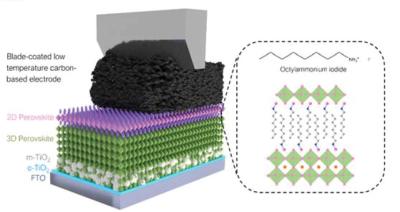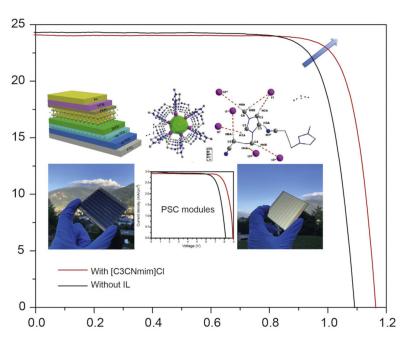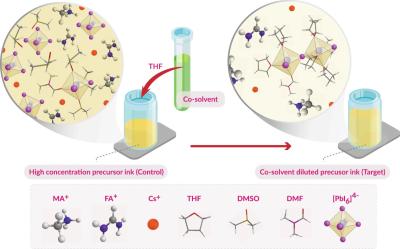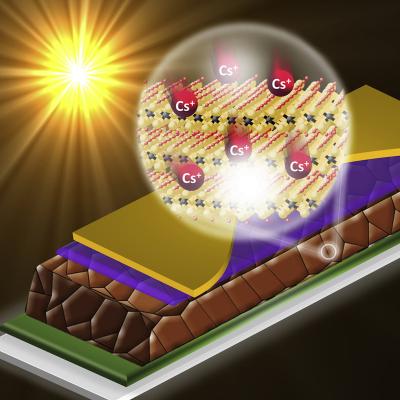![]() EPFL is a Switzerland-based technical university and research center. EPFL is focuses on three missions: teaching, research and technology transfer. EPFL works together with an extensive network of partners including other universities and institutes of technology, secondary schools and colleges, industry and economy, political circles and the general public.
EPFL is a Switzerland-based technical university and research center. EPFL is focuses on three missions: teaching, research and technology transfer. EPFL works together with an extensive network of partners including other universities and institutes of technology, secondary schools and colleges, industry and economy, political circles and the general public.
EPFL does extensive perovskite R&D work and is responsible for many publications and advancements in the field.
Route Cantonale
1015 Lausanne
Switzerland
The latest EPFL perovskite news:
Researchers use a 2D perovskite passivation layer as an electron blocking layer in 18.5%-efficient carbon-electrode perovskite solar cell
Researchers from Fraunhofer Institute for Solar Energy Systems ISE, EPFL, Korea Basic Science Institute (KBSI) and Morocco's Abdelmalek Essaadi University have developed a perovskite solar cell with a carbon electrode that achieved 18.5% efficiency.
 Schematic diagram of the investigated low-temperature carbon electrode-based PSC with 3D/2D perovskite treated by OAI. Image from study
Schematic diagram of the investigated low-temperature carbon electrode-based PSC with 3D/2D perovskite treated by OAI. Image from study
The solar cell also reportedly retained 82% of their efficiency after 500 hours of continuous illumination. The cell is produced via all low-temperature processes that could likely be scaled into low-cost, large-scale manufacturing ' making the approach attractive despite achieving lower efficiency than record-setting cells.
EPFL team develops tandem solar cells with 29.2% efficiency
EPFL scientists in Neuchâtel have reported a tandem solar cell that can deliver a certified efficiency of 29.2%. This achievement was made possible by combining a perovskite solar cell with a textured silicon solar cell.
One obstacle the team encountered was finding a way to evenly coat the silicon surface'which is intentionally rough, or textured'with a thin film of halide perovskites. A textured surface is used in order to minimize light reflection. This kind of system can already be found in all commercially available crystalline silicon cells.
Researchers design ionic liquid-based perovskite solar cell with 22.86% efficiency
Researchers from EPFL, Tianjin University, Nanjing Tech University, The University of Tokyo, Shanghai University and Toyota Motor Corporation have used ionic liquids (ILs) with halide anions as additives to improve the performance and stability of a perovskite solar cell.
 Image from study in Cell Reports Physical Science
Image from study in Cell Reports Physical Science
Ionic liquids are viewed as a "greener" alternative to organic solvents due to their lower volatility and flammability, as well as to their wide liquid-state window.
Researchers use TiO2 nanoparticles for stable and efficient perovskite modules
A team of scientists, led by Mohammad Nazeeruddin at Ãcole polytechnique fédérale de Lausanne (EPFL), has found a way to address the scaling up challenges of perovskites. The scientists have developed an easy solvothermal method to produce single-crystalline titanium dioxide rhombohedral nanoparticles that can be used to build a perovskite film.
The new structure is said to feature a lower amount of lattice mismatches, referring to the "ladder-like" structure of the titanium dioxide nanoparticles. This translates into a lower number of defects, which ensures better electron flow throughout with lower power loss.
Researchers develop low-temperature planar n–i–p perovskite module with 19.1% efficiency
Researchers from the University of Rome Tor Vergata's Centre for Hybrid and Organic Solar Energy (CHOSE), IMEC and EPFL have reported on a solar module with an efficiency of 20.72%, based on tin oxide (SnO2) as an electron transport layer, an organometal halide perovskite layer, organic halide salt phenethylammonium iodide (PEAI) as a passivation agent, and Spiro-OMeTAD as the hole transport layer (HTL).
The international research team presented its low-temperature planar perovskite module with an n'i'p architecture, an aperture area of 11'cm2, and a geometrical fill factor of 91%.
New approach could allow for rapid and low-cost production of perovskite solar cells
An international team of researchers from EPFL, North Carolina State University, Centre for Hybrid and Organic Solar Energy (CHOSE) at the University of Rome Tor Vergata and Uppsala University has demonstrated a technique for producing perovskite photovoltaic materials on an industrial scale, which could reduce the cost and improve the performance of mass-produced perovskite solar cells. The technique is low-cost, simple and energy-efficient.

'In the lab, researchers produce perovskite photovoltaic materials using a technique called spin coating, which creates a thin film of perovskite on a substrate ' but only on a small scale,' says Aram Amassian, co-corresponding author of a paper on the work and a professor of materials science and engineering at North Carolina State University.
Researchers use quantum dots to boost perovskite solar cell efficiency & scalability
Researchers at EPFL, Zurich University of Applied Sciences, Ulsan National Institute of Science and Technology, University of Ulsan and Uppsala University have designed an innovative way to increase the performance of perovskite solar cells and maintain it at a high level even at large scales. The new approach replaces the electron-transport layer with a thin layer of quantum dots.
With this new approach, the team, led by Professor Michael Grätzel at EPFL and Dr Dong Suk Kim at the Korea Institute of Energy Research, addressed one of the major obstacles facing the commercialization of perovskite solar cells - the fact that their power-conversion efficiency and operational stability drop as they scale up, making it a challenge to maintain high performance in a complete solar cell.
New isomer passivation method could yield efficient and stable perovskite solar cells
An international team of researchers recently tested a new way of passivating defects in perovskite solar cells. Using a tailored arrangement of atoms, the team managed to overcome challenges related to the formation of a two-dimensional perovskite layer on top of the active cell material, and reach 21.4% conversion efficiency for a 26cm2 active area, which is said to be a record for a perovskite device of this size.
Passivation layers, deposited on top of the perovskite material, play an essential role in reducing material defects and unwanted reactions within the material, to improve both performance and stability. One strategy that has been found effective is the use of alkylammonium halides. In many cases these form an additional two-dimensional perovskite layer on top of the perovskite, which can improve device stability but also negatively affect performance.
New technique could help create better perovskite materials
A recent study by Lawrence Berkeley National Laboratory (Berkeley Lab), Technische Universität München, EPFL and The Pennsylvania State University has found that solar materials manufacturing could be aided by a new instrument that uses two types of light ' invisible X-ray light and visible laser light ' to probe a perovskite material's crystal structure and optical properties as it is synthesized.
'When people make solar thin films, they typically have a dedicated synthesis lab and need to go to another lab to characterize it. With our development, you can fully synthesize and characterize a material at the same time, at the same place', said Carolin Sutter-Fella, a scientist at Berkeley Lab's Molecular Foundry.
Researchers use Cesium-doped Ti3C2Tx MXene for efficient and thermally stable perovskite solar cells
Researchers from The University of Queensland, EPFL, Griffith University and NIMS have studied how doping can help in overcoming some of perovskite solar cells' drawbacks. The researchers found that the efficiency and thermal stability of the doped cells significantly outperformed those that were not doped.
“The PSCs that had doped cells showed a remarkable solar conversion efficiency that exceeded 21 per cent,†the team reported.
Pagination
- Previous page
- Page 3
- Next page


